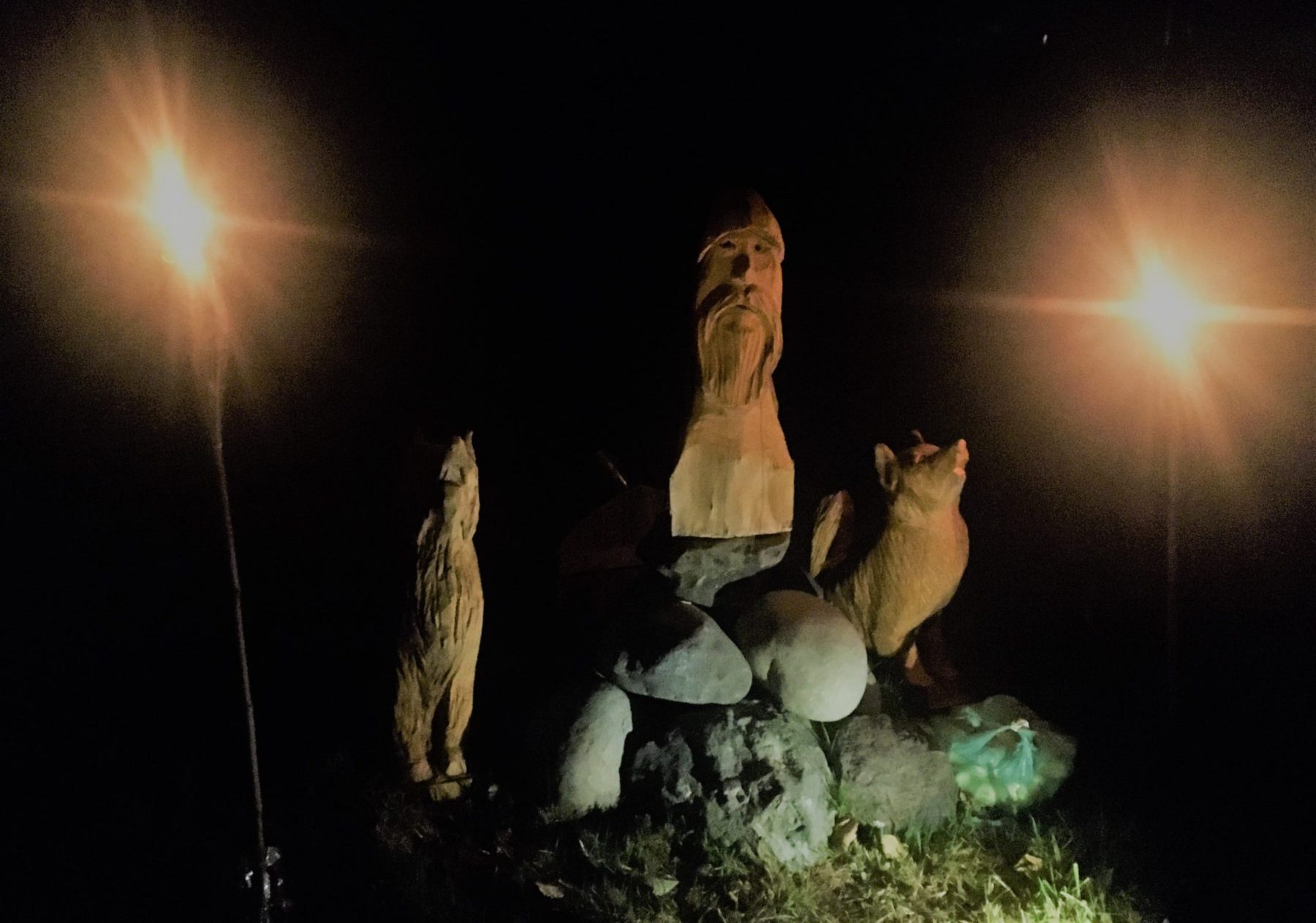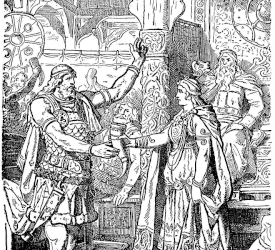There is a modern trend in germanic heathenry circles to hail and praise Loki, as if he is a god worthy of praise. I like to credit the marvel movies for this trend. These movies, and even the comic books written decades ago, have contributed to a confusion that seems to have gripped the collective mind of society about who or what these gods were and were not. However, no matter how entertaining these movies or comic books appear to be, their portrayal of the Norse and Germanic gods has no basis in the original traditions of our folk. One of these many misconceptions revolves around the character of Loki. The marvel world would imagine and portray Loki as this jester like God, the “trickster” type character that “magically” represents an archtypal chaotic force that’s always up to no good’ tolerated by the rest of the gods as part of the family. This perception could not be further from the truth when comparing it to the broader germanic and nordic sources that we have. Infact, the tale of Loki as told in the traditional sources is a tale of treachery, murder and destruction.
I have seen a lot of discussion about Loki throughout the years and it has always struck me as odd when I see this debate because it’s almost more of a social statement to support Loki than a true desire to understand his story, what crime he committed, what his punishment was for this crime and what happens to those that follow him – Spoiler Alert it’s not good.
Following the epic methodology when interepreting the chronology of events in the lore, as it tells the history of creation from the begining of time until the end of times, we can understand how the trial and condemnation of Loki came about and what its results were. It is not within the scope of this article to revisit all of the crimes committed by Loki but rather to focus on his greatest crime and his condemnation by the gods and what happens to those that follow him. Let me begin by summarizing a few things about Loki that should be understood before examining these three things.
The first appearance of Loki in the lore is late in the chronology of events and he appears out of no where when he is found walking with Odin and Thor. This supports the idea that Loki was originally known by another name before his abrupt appearence and that at some point a name taboo related to the true name of Loki came into effect. This idea is also supoported by the lack of etymology of the word/name of Loki in the broader Indo European tradition. The only references of this name exists soley in Nordic/Scandavian and Icelandic material. It appears a name taboo did infact exist and although the true identity of who loki was is not within the purview of this article, this author holds the personal opinion that Loki may have been no other than Lodur the brother of Odin and Hoenir (The trio featured as the brothers that slew Ymir and created the worlds and fashioned man, each imparting certain gifts to man and woman). Although there does not exist enough evidence to definitively identify these two as the same entity there are a few clues to this pairing.
The first clue is the abrupt disappearence of Lodur from the lore and then the sudden appearence of Loki shortly thereafter. This by itself doesn’t mean much, but there is a story about Lodur that many people do not know. There is a tale about Lodur becoming jealous of Odin and attempting to steal the sacred mead from Mimir’s well. This sacred mead allows the one that possesses it to control the fate or destiny of the universe. As the story goes all three sons of Borr, Odin and his two brothers Hoenir and Lodur, were apprentices of Mimir. Odin excelled in his tutelage and was choosen by Mimir as his successor and Lodur considering himself better than Odin rebels at what he perceives as an injustice and attempts to steal the mead. The story is based on a passage in Saxo’s Danish History Book 1 and is incomplete, but it is thought that this is when Lodur becomes Surt (Viktor Rydberg goes into detail about Lodur’s history in his Investigation Into Germanic Mythology and Carla O’Harris expands this connection in her work, identifying Surt as Lodur). Surt is the one that rebels against the gods and rises at ragnarok to destroy the world with his sword (the same sword that Freyr gave to gerd while under a seidhr spell put on him by Angrboda, the mother of gerd). This theory is also supported by the etymology of the name Lodur, which means “The Fire Producer”. If this transition of Lodur becoming Surt is accurate, then it only makes sense about his disappearence in the lore that some sort of name taboo happened producing the sudden appearence of a new character in the lore called Loki, whom some scholars also associate with fire.
What crime could lead to a name taboo? What horrendous act must a god commit to be bannished from the annuls of history in the conscousness of the folk that even his name is forbidden to speak? According to the traditions handed down to us through out the ages and preserved in Icelandic, Nordic and Danish sources; that crime is the murder of a god. This is not just the murder of a god, but the murder of the “most beloved god” of all i.e. Baldr. This is exactly what Loki is responsible for as he was the prinicple instigator of Baldrs death, the only one in all of creation that did not weep for Baldr, thus sealing his fate.
In germanic law their is a concept of restoring ones honor when a dishonorable act is done. Just as Loki restored the honor of Sif after cutting her hair (an act that was reserved only for women that committed adultry) by facilitating the creation of sifs magical giolden hair, Loki had an opportunity to restore his honor for his role in the death of Baldr by weeping for him with the rest of creation, he choose not to. The gods then assembled at Aegirs hall and the trial of Loki then begins and is recorded in the Lokasenna. What comes of Loki’s trial is his conviction of the murder of Baldr by the gods. Loki then attempts to flee the gods. He is eventually caught and bound with the entrails of his own son by Vali and his mouth is sewn shut so that he should not speak any words. A venomous snake is placed over his head that drops its poison onto Loki. Sigyn, Loki’s wife, holds a bowl over his head to catch the snake venom trying to prevent it from harming him. It is there in that cave where Loki and his wife will remain, bound and rendered powerless until ragnarok. This bindiing is profoundly magical and renders Loki impotent until Ragnarok when he breaks free of his binding to rise with the Jotun to fight against the gods in their attempt to destroy them. Loki and/or Sutr and their army kill many gods and destroy the world, but ultimately their actions are unsuccesful and the new world rises from Jormungandr with the survivng gods while the soul of the folk is reborn by Hoenir who remained at Mimir’s well until after ragnarok to stir his Odr and brings forth the next creation as Baldr and Nanna return.
This story makes it obvious to me why hailing or praising Loki is pointless in the first place. He has no ability to procure benefit to those that do so as he has been rendered powerless by the gods when he was bound. So why do people insist on hailing this cursed being? I personally believe those that do so mostly do this from ignorance. They do not know the lore, its history/epic nature and mostly do this as a social statement to appear cool and rebellious. For if someone knowingly hails and prays to loki understanding his true nature, then this person has intelligently decided to side with the enemies of the gods and seeks to destroy all that the gods have created and that person shares the same fate as Loki and is ultimately destroyed during ragnarok.
It should be noted that there are only two possible depictions of Loki in archeaological finds; The Kirkby Stephen Stone and possibly the Gosforth Cross. Both images bare no name to definitively identify the character portrayed on these two finds, but on both depictions the character is bound and on the Gosforth cross there is an image of a woman standing over a bound figure, while holding a bowl with a snake over head. The imagery matches the story that has survived in the literary sources. However, the lack of any amulets, charms or other runic carvings that display the name “Loki” supports the name taboo associated with this condemned being and strongly suggests that Loki worship was completely unknown to our ancestors. Infact we find no examples in any histories, sagas, manuscripts, place/location names nor any other known source attesting to any form of Loki worship.
There is one story that is known from Saxo grammaticus, that some have misidentified as an example of a king praying to Loki; but even in this single example (which actually is not Loki that’s being prayed to), the end result of the king and his followers after their devotional prayers is misfortune and destruction. It would take a very distorted reading of Saxo, Book 8 to arrive at the conclusion this story represents an example of Loki worship by royalty, no less. Some claim that Saxo was writing about Loki Laufeyjarson and referring to him as Útgarða-Loki. First, we do not know that Saxo was writing about “Loki Laufeyjarson”.He speaks of a bound figure in the places of torment in hell named Utgard-Loki. In Snorri’s Edda, Utgard-Loki is a separate figure, a giant also named Skyrmir, who fools Thor, Loki, Thjalfi and Roskva with illusions. If he is speaking of Loki Laufey’s son, then he is speaking of him when he is bound in Niflhel by the gods.
Saxo says: “While he was thus inclined, certain men who wished ill to Thorkill came and told Gorm that it was needful to consult the gods, and that assurance about so great a matter must be sought of the oracles of heaven, since it was too deep for human wit and hard for mortals to discover. Therefore, they said, Utgarda-Loki must be appeased,…. he must first travel to a grassless land which was veiled in deep darkness; but he must first voyage for four days, rowing incessantly, before he could reach his goal. There he could visit Utgarda-Loki, who had chosen hideous and grisly caves for his filthy dwelling. Thorkill was much aghast at being bidden to go on a voyage so long and hazardous; …With his crew he entered a land where an aspect of unbroken night checked the vicissitude of light and darkness. He could hardly see before him, but beheld a rock of enormous size. Wishing to explore it, he told his companions, who were standing posted at the door, to strike a fire from flints as a timely safeguard against demons, and kindle it in the entrance.Then he made others bear a light before him, and stooped his body through the narrow jaws of the cavern, where he beheld a number of iron seats among a swarm of gliding serpents. Next there met his eye a sluggish mass of water gently flowing over a sandy bottom. He crossed this, and approached a cavern which sloped somewhat more steeply. Again, after this, a foul and gloomy room was disclosed to the visitors, wherein they saw Utgarda-Loki, laden hand and foot with enormous chains. Each of his reeking hairs was as large and stiff as a spear of cornel. Thorkill (his companions lending a hand), in order that his deeds might gain more credit, plucked one of these from the chin of Utgarda-Loki, who suffered it. Straightway such a noisome smell reached the bystanders, that they could not breathe without stopping their noses with their mantles. They could scarcely make their way out, and were bespattered by the snakes which darted at them on every side. Only five of Thorkill’s company embarked with their captain: the poison killed the rest. The demons hung furiously over them, and cast their poisonous slaver from every side upon the men below them. But the sailors sheltered themselves with their hides, and cast back the venom that fell upon them. One man by chance at this point wished to peep out; the poison touched his head, which was taken off his neck as if it had been severed with a sword. Another put his eyes out of their shelter, and when he brought them back under it they were blinded. Another thrust forth his hand while unfolding his covering, and, when he withdrew his arm, it was withered by the virulence of the same slaver. They besought their deities to be kinder to them; vainly, until Thorkill prayed to the god of the universe, and poured forth unto him libations as well as prayers; and thus, presently finding the sky even as before and the elements clear, he made a fair voyage. And now they seemed to behold another world, and the way towards the life of man. At last Thorkill landed in Germany, which had then been admitted to Christianity.
So after an encounter with the “god” Utgard-Loki, nearly dying and losing a number of his men, Thorkill turns to the God of the Universe and converts to Christianity — the fate of all Loki worshippers apparently.
So now lets look at the circumstances that brought Thorkill to that “god”. Saxo says: Harald’s son GORM won no mean place of honour among the ancient generals of the Danes by his record of doughty deeds. For he ventured into fresh fields, preferring to practise his inherited valour, not in war, but in searching the secrets of nature; and, just as other kings are stirred by warlike ardour, so his heart thirsted to look into marvels; either what he could experience himself, or what were merely matters of report. And being desirous to go and see all things foreign and extraordinary, he thought that he must above all test a report which he had heard from the men of Thule concerning the abode of a certain Geirrod. For they boasted past belief of the mighty piles of treasure in that country, but said that the way was beset with peril, and hardly passable by mortal man. …Three hundred men announced that they had the same desire as the king; and he resolved that Thorkill, who had brought the news, should be chosen to guide them on the journey, as he knew the ground and was versed in the approaches to that country. Thorkill did not refuse the task.
…Now when they had come to Halogaland (Helgeland), they lost their favouring breezes, and were driven and tossed diverse ways over the seas in perilous voyage. At last, in extreme want of food, and lacking even bread, they staved off hunger with a little pottage….perceiving that land was near, they bade a youth of great nimbleness climb to the masthead and look out; and he reported that a precipitous island was in sight. All were overjoyed, and gazed with thirsty eyes at the country at which he pointed,…Then Thorkill told them to take no more of the herds that were running about in numbers on the coast, than would serve once to appease their hunger. If they disobeyed, the guardian gods of the spot would not let them depart. But the seamen, more anxious to go on filling their bellies than to obey orders, postponed counsels of safety to the temptations of gluttony, and loaded the now emptied holds of their ships with the carcases of slaughtered cattle…On the following night monsters dashed down upon the shore, filled the forest with clamour, and beleaguered and beset the ships. One of them, huger than the rest, strode over the waters, armed with a mighty club. Coming close up to them, he bellowed out that they should never sail away till they had atoned for the crime they had committed in slaughtering the flock, and had made good the losses of the herd of the gods by giving up one man for each of their ships. …[They escape and enter the paradise land of the giant Gudmund, filled with treasures, and Guldmund leads them to the gates of Niflhel] …Gudmund perceived that Thorkill was shrewder than he at every point; so, despairing to accomplish his treachery, he carried them all across the further side of the river, and let them finish their journey. They went on; and saw, not far off, a gloomy, neglected town, looking more like a cloud exhaling vapour. Stakes interspersed among the battlements showed the severed heads of warriors and dogs of great ferocity were seen watching before the doors to guard the entrance. Thorkill threw them a horn smeared with fat to lick, and so, at slight cost, appeased their most furious rage. High up the gates lay open to enter, and they climbed to their level with ladders, entering with difficulty. Inside the town was crowded with murky and misshapen phantoms, and it was hard to say whether their shrieking figures were more ghastly to the eye or to the ear; everything was foul, and the reeking mire afflicted the nostrils of the visitors with its unbearable stench. Then they found the rocky dwelling which Geirrod was rumoured to inhabit for his palace. They resolved to visit its narrow and horrible ledge, but stayed their steps and halted in panic at the very entrance. {There they find the giant Geirrod and his daughters, whom Thor killed and sent to Niflhel].
After much loss of life, they attempt to return home. Saxo says: The king bewailed his friend’s disaster and departed hastening on his voyage. This was at first prosperous, but afterwards he was tossed by bad weather; his men perished of hunger, and but few survived, so that he began to feel awe in his heart, and fell to making vows to heaven, thinking the gods alone could help him in his extreme need. At last the others besought sundry powers among the gods, and thought they ought to sacrifice to the majesty of diverse deities; but the king, offering both vows and peace-offerings to Utgarda-Loki, obtained that fair season of weather for which he prayed. [So the men pray to the powers of heaven for safety, and the King decides to pray to Utgard-Loki instead, who is described as a bound demon in the text] and his prayer is answered.
Here is the crux. Saxo continues: Coming home, and feeling that he had passed through all these seas and toils, he thought it was time for his spirit, wearied with calamities, to withdraw from his labours. So he took a queen from Sweden, and exchanged his old pursuits for meditative leisure. His life was prolonged in the utmost peace and quietness; but when he had almost come to the end of his days, certain men persuaded him by likely arguments that souls were immortal; so that he was constantly turning over in his mind the questions, to what abode he was to fare when the breath left his limbs, or what reward was earned by zealous adoration of the gods. While he was thus inclined, certain men who wished ill to Thorkill came and told Gorm that it was needful to consult the gods, and that assurance about so great a matter must be sought of the oracles of heaven, since it was too deep for human wit and hard for mortals to discover. Therefore, they said, Utgarda-Loki must be appeased, and no man would accomplish this more fitly than Thorkill.
So driven by greed, King Gorm wanted to go see if the tales of Gudmund the giant and his treasure were true. Losing a gret deal of men, and almost dying in the process himself, King Gorm prays to the demon Utgard-Loki and his prayer is answered. Then at the end of a prolonged life, King Gorm was convinced by some men that souls were immortal, and as a result he contemplated where we would go when he died. In this state, enemies of Thorkill convinced the king that the powers of heaven insisted that Utgard-Loki (the bound demon he had previously prayed to) must be appeased and that Thorkill was just the man for the job! So Gorm’s praying to Loki was driven by his extreme need and fear for his life, and he had to atone for doing so or risk not going to heaven.
Saxo continues: Others, again, laid information against him as guilty of treachery and an enemy of the king’s life. Thorkill, seeing himself doomed to extreme peril, demanded that his accusers should share his journey. Then they who had aspersed an innocent man saw that the peril they had designed against the life of another had recoiled upon themselves, and tried to take back their plan. But vainly did they pester the ears of the king; he forced them to sail under the command of Thorkill, and even upbraided them with cowardice. Thus, when a mischief is designed against another, it is commonly sure to strike home to its author. And when these men saw that they were constrained, and could not possibly avoid the peril, they covered their ship with ox-hides, and filled it with abundant store of provision. In this ship they sailed away, and came to a sunless land, which knew not the stars, was void of daylight, and seemed to overshadow them with eternal night. Long they sailed under this strange sky; at last their timber fell short, and they lacked fuel; and, having no place to boil their meat in, they staved off their hunger with raw viands. But most of those who ate contracted extreme disease, being glutted with undigested food..(This is the crew that will sail into Niflhel, visit the hall on the Nastronds mentioned in Voluspa, before entering the deadly cave of Utgard-Loki, King Gorm’s “god”
That is the strongest piece of evidence a few people have used to justify the worship of Loki, and it occurs in a heavily euhemerized and Christianized text. Loki can only be understood as a god to be worshipped if we ignore the context of the entire passage. He is a “god’ chained in Niflhel, the places of punishment in the lower world, and any contact with him is deadly. He is clearly NOT one of the “powers of heaven” mentioned in the text.
So according to Saxo, if this is Utgard-Loki, he too is chained up in the places of punishment just as Snorri and the Eddic poems state. Who would worship a bound enemy of the gods destined to lead the inhabitants of Niflhel in the ship Naglfari to battle the gods to the death? Only a deranged mind would knowingly stand against the gods and godesses of our folk and those that do so, openly confess their fate and their own impending doom being cursed by the gods and nothing but Misfortune awaits them.






